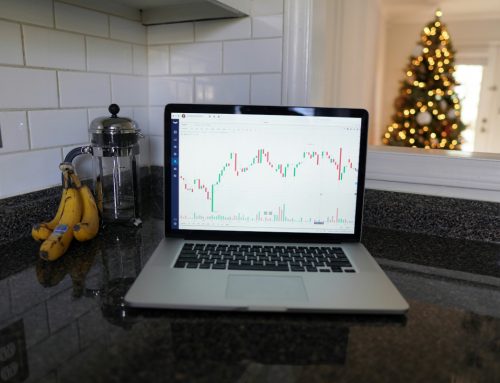Whether you’re a seasoned day trader looking to transition to something new and exciting or you’re entirely new to the world of investing, you’re in the right place. Today, we’re going to teach you the basics of swing trading.
You’ll learn what exactly a swing trade is and how this type of strategy works. And by the end of this article, you’ll feel confident taking the information we’ve provided and executing your first swing trade. We’ve got a lot to cover, so let’s get right into swing trading basics below.
Featured Courses:
First, What is Swing Trading & How Does it Work?
What are swing trades, exactly? In swing trading, investors buy and sell financial instruments over a short period of time in order to take advantage of temporary market swings. The goal is to make quick profits by capitalizing on both upward and downward price movements.
What’s unique about this strategy – especially compared to long-term trading – is you can make money whether an asset is trending upward or downward. You won’t be concerned about the fundamentals behind a company – which means you don’t need to waste time keeping up with company news.
The key to swing trading success is timing. You’re trying to make profits along the small 3-5% changes in price along an asset’s overall price trajectory. This can be done manually by tracking swing trade indicators, but we suggest using VectorVest, an automated swing trading platform that eliminates emotion and human error from the equation – two things beginner traders are guilty of. We’ll talk more about that later on.
How long is a swing trade usually? The answer varies from situation to situation. It depends on how volatile an asset’s price movement is, and your specific risk tolerance. With that said, swing trades typically last anywhere from a few days to a few weeks at most. Any longer than that and you’re venturing more into position trading. If your trades don’t last at least a few days, then you’re day trading.
The Basics of Swing Trading: How to Execute Your First Trade
Ready to discover the basics of swing trading? We highly recommend you read our more in-depth guide covering swing trading for beginners before you actually get started trying to execute your first trade.
But because you came here simply to learn the basics of swing trading, we’ll cover the general steps standing between you and your first trade below. First things first – come up with your strategy.
Develop Your Strategy
Before you start looking for opportunities in the stock market, you need to figure out what your goals are with swing trading. Are you simply looking to earn some supplemental income in your spare time? Or, are you trying to make a full-time income? Your goals will influence the strategy you follow.
One of the most important elements of your strategy is your risk tolerance. There are a few different types of traders:
- Conservative (low risk, moderate reward)
- Prudent (moderate risk, medium reward)
- Aggressive (high risk, high reward)
- Speculative (very high risk, very high reward)
More conservative or prudent traders will capture profits after just 3-5% of favorable price movement. Aggressive and speculative traders will let their positions run longer with the hope of capturing more profits – sometimes up to 10%. The trade-off is in how much risk each trader is subject to.
Obviously, the goal is to keep your losses infrequent and small – but they will occur, even if you take the most conservative approach to trading. Fortunately, you can use tools like stop losses and take profit orders to prevent large account blow-ups from occurring. We’ll talk more about that in a later section. For now, let’s talk about how you’ll find that first opportunity.
Uncover an Opportunity Using Technical Analysis
Now it’s time to start looking for opportunities. This is where technical analysis comes in. Our complete guide on how to find stocks to swing trade is a great resource for this. Here are the basics of finding swing trading opportunities, though:
You’ll want to create screeners within whichever platform you’re trading on, which is basically a set of criteria you provide. The screener will pull in potential trading candidates that meet your criteria – whether that criteria is based on price movement, volume, or other indicators.
When the right opportunity looks to present itself, quickly analyze and confirm the opportunity using swing trade indicators like moving averages and stochastics. This will give more insight into potential entry points and exit points as well – which is what we’ll talk about in the next section.
If you follow the advice we provide later on and invest in a VectorVest subscription, you actually don’t even need to do any work. Just open up our top stock picks on any given day and choose the opportunities you think make the most sense.
Time Your Entry
Earlier, we mentioned that swing trading is all about timing. Remember – your goal is simply to ride a short-term wave upwards as the stock’s price moves in the right direction, and get out before that trend starts to subside and reverse. This is a lot easier when you have the right tools in your arsenal.
Going into any trade, you should have mapped out your strategy from start to finish. You should have your entry point and exit point already in mind – you don’t want to be making this all up as you go along in real-time. By the time you’ve found your exit, it could be too late.
How much money should you trade in any given opportunity, though? This will depend on your specific account – but a good rule of thumb is to put no more than 1-2% of your total capital into any given position.
At first, you may only swing trade a few stocks at a time. But as you get the swing of things you’ll start spreading your capital across more and more opportunities at the same time – and you need to make sure you have cash available so you don’t miss out on opportunities.
Monitor Your Position – But Create Stop Losses & Take Profits, Too
Once you’ve entered your position the fun part begins – it’s time to sit back and monitor your position. However, there really shouldn’t be much work left at this point. That’s because we recommend you create stop losses and take profit orders at the start of every trade.
A stop loss is an order that will execute if a stock’s price falls below a certain threshold. This protects you from facing huge losses that could blow up your account. Take profit orders, on the other hand, execute automatically when the stock’s price reaches above a certain point. This helps prevent you from getting greedy and trying to squeeze out a few extra percentage points from your trade – only to see the trend reverse and all your profit potential disappear.
Both of these are talked about more in-depth in our article covering when to cut losses on stock. However, your stop loss and take profit orders should be set in accordance with your trading strategy. And while they are going to automate your trade for you, you can still manually monitor your position and make adjustments as needed.
For example, if your position remains stagnant for too long and you’re not seeing the return you’d hoped for, you can close out your position manually and move on to the next opportunity.
Capture Profits, Rinse, and Repeat!
Once you’ve executed your first profitable trade, it’s time to celebrate – no matter how small the return is, you did it! This will be a huge mindset shift for you as you’ll realize that if you did it once, you can do it again. And again. And again.
Over time, you’ll get better at uncovering opportunities and executing your trades. Your account size will grow, too, creating more excitement and potential in your strategy.
And while that is really all you need to know for the basics of swing trading, it’s time to discover a more simple, foolproof approach to swing trading…
Looking for the Most Simple, Straightforward Way to Get Started Swing Trading Successfully?
As you can see from our conversation on the swing trading basics above, it’s quite simple – but by no means is it easy. There will be trials and tribulations along your journey, and you will face losses. The key is in minimizing those losses and trying to speed up the learning curve as much as possible.
That’s why the best advice we can offer beginner swing traders is to invest in software that simplifies things for you, helping you tune out the noise and eliminate some of the complexity of investing. And for the best platform for swing trading, you can look no further than VectorVest!
How it Works
VectorVest is the #1 stock analysis software. It tells you what to buy, when to buy it, and when to sell it – eliminating any human error, guessing games, or emotion from your decision-making. Instead of relying on complex technical indicators and following pattern charts, you can rely on three simple ratings: relative value (RV), relative safety (RS), and relative timing (RT).
These intuitive ratings tell you everything you need to know about a stock. They’re easy to interpret, as they sit on a straightforward scale of 0.00-2.00 – with 1.00 being the average. Just pick stocks with the highest overall ratings to win more trades!
Or better yet, just follow the buy, sell, or hold recommendation VectorVest offers for any given stock, at any given time. Our system has outperformed the S&P 500 by 10x over the last two decades – so you can rest assured you’re following a tried-and-true approach to investing in the stock market.
The best part? You don’t have to do any of the hard work of uncovering your opportunities day in and day out. Just rely on our pre-built stock picks – which bring the best opportunities to your screen on a daily basis! Whether you’re looking for stocks in certain industries, the biggest boomers on a given day, or the safest stocks – we have a screener for it.
If you want to see the system in action, you can get a free stock analysis today for any stock you’d like. Then, invest in your financial future by setting up your Vectorvest subscription today – we even offer a mobile stock advisor app to help you bring your trades on the go.
Frequently Asked Questions About the Basics of Swing Trading
Before we bring our discussion on the swing trading basics to a close, we want to discuss a few commonly asked questions by new swing traders:
Is Swing Trading Good for Beginners?
Absolutely – swing trading is less complex than day trading, but allows you to generate income in the here-and-now unlike long-term investing. We have an in-depth article discussing the pros and cons of swing trading to help you determine if this is the right investment strategy for you. But, with a commitment to learning how to swing trade, the right tools, and a consistent strategy, you can enjoy a high swing trading success rate! Just how much can you expect to earn, though?
How Profitable Can Swing Trading Be?
Is swing trading profitable? What sort of realistic swing trading returns can you expect? These are two of the most common questions we get asked. And the answers are yes, but it depends on your risk tolerance, how large of an account you’re trading, and how consistent you are. Earning a full-time living from swing trading is not rare.
Why Do Most Swing Traders Fail?
Most swing traders fail because they lack the consistency and dedication necessary for this strategy. Most look at swing trading as an easy way to get rich without work. That’s not the case. Swing trading is complex and it takes dedication to start earning consistent returns. If you are here because you want to start making a thousand dollars a day right now, with no skin in the game, swing trading is probably not for you.
How to Learn Swing Trading for Beginners?
This article on the basics of swing trading is a great starting point. We also have a full guide on how to learn swing trading that we highly recommend you read next.
Really, though, the best way to learn swing trading is to invest in a paid course. This will speed up the timeline dramatically in getting your first profitable trade executed, and decrease your chances of failure early on.
From there, the best next step is paper trading – which allows you to simulate trades in real-time without the stress of losing real money. This is something you can do within the VectorVest software, too, so you can get comfortable with using the system. Once you feel confident in your abilities, you can move on to small account trading with real money.
Can You Only Swing Trade Stocks?
Contrary to what many beginners believe, swing trading is a strategy that can be used to trade any type of asset on the stock market. Not just stocks. You can also try swing trading options or learn how to swing trade ETFs. With that said, stocks are a great starting point for beginners.
Wrapping Up the Swing Trading Basics
We hope you feel more confident in your next steps after reading our guide on the swing trading basics. As you can see, getting started isn’t nearly as daunting as you may have thought. Especially when you arm yourself with the right information and tools – both of which are available here at VectorVest. At this point, it’s time to continue your education and work your way closer to making that first profitable trade.








Leave A Comment